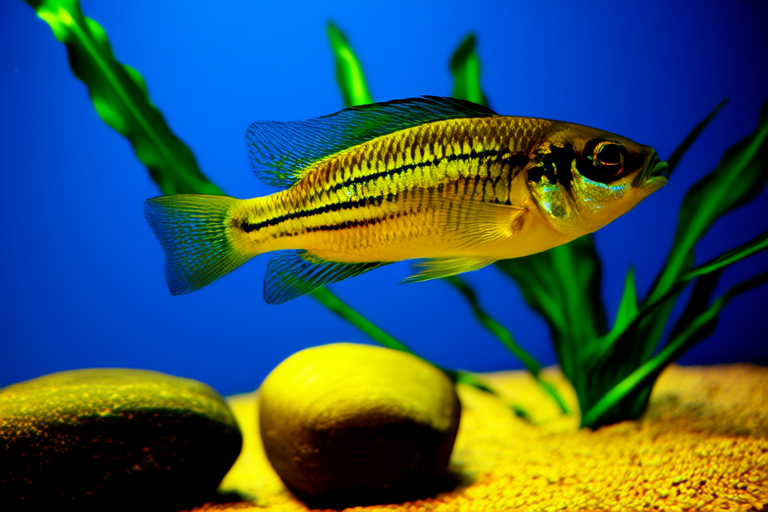Rajah Cichlid: A Comprehensive Care Guide
Welcome to our guide on caring for Rajah cichlids! These vibrant fish are a favorite among aquarium enthusiasts due to their striking appearance and interesting behaviors. Whether you’re a beginner or an experienced aquarist, this guide will help you understand and meet the needs of your Rajah cichlids.
Social Behavior
Rajah cichlids (Aequidens rivulatus) are territorial and can be aggressive, especially during spawning. They prefer to live in pairs or small groups, and it’s best to avoid housing them with smaller or less aggressive species. Males are more territorial than females and may display dominant behavior, including chasing or fin-nipping. However, they can coexist peacefully with other robust cichlids of similar size. It’s important to observe their interactions closely to ensure compatibility.
For beginners, it might be challenging to predict which fish will get along well with Rajah cichlids. One solution is to introduce new tank mates gradually and monitor their behavior. If conflicts arise, consider rearranging the tank layout to create separate territories or even removing incompatible species.
Feeding Habits
Rajah cichlids are omnivores with a preference for plant-based foods. In the wild, they feed on algae, insects, and small invertebrates. In captivity, they thrive on a diet that includes high-quality pellets, flakes, and occasional treats like bloodworms, brine shrimp, or vegetables such as zucchini and spinach. It’s essential to provide a balanced diet to maintain their health and coloration.
To ensure proper nutrition, vary their diet regularly. Overfeeding can lead to water quality issues, so feed them only what they can consume within a few minutes. Additionally, maintaining good water quality through regular water changes is crucial for their overall well-being.
Breeding Tendencies
Rajah cichlids are monogamous and form strong pair bonds. Breeding typically occurs when the water conditions are optimal, such as stable temperature and pH levels. The female lays eggs on a flat surface, usually a rock or the aquarium glass, and the male fertilizes them externally. Both parents guard the eggs and newly hatched fry until they become free-swimming.
Setting up a breeding tank with ample hiding spots and caves can encourage breeding behavior. Once the fry hatch, provide them with infusoria or microworms as food. Gradually transition them to larger, more substantial meals as they grow. Separating the fry from the adults after a few weeks ensures their safety and promotes healthy development.
Environmental Needs
Rajah cichlids require specific environmental conditions to thrive. They prefer slightly acidic water with a pH range of 6.0 to 7.0 and a temperature between 75°F and 82°F (24°C to 28°C). A spacious tank with plenty of hiding places and open swimming areas is ideal. Adding driftwood, rocks, and plants creates a natural environment that mimics their native habitat.
Regular maintenance, including partial water changes and cleaning the substrate, helps prevent the buildup of harmful substances and keeps the water clean. Using a high-quality filter is also beneficial for maintaining water quality. Proper filtration not only removes waste but also oxygenates the water, creating a healthier environment for your fish.
Common Challenges and Solutions
One common challenge faced by aquarists is aggression among Rajah cichlids. To mitigate this, provide ample space and hiding spots. Another issue is difficulty in breeding. Creating a breeding tank with appropriate conditions can increase the chances of successful reproduction. Water quality problems, such as ammonia spikes, can also be problematic. Regular water changes and monitoring water parameters are key to preventing these issues.
For beginners, it’s recommended to start with a community tank setup, ensuring all species have compatible temperaments. As you gain experience, you can experiment with different setups and species combinations. Remember, patience and careful observation are crucial in addressing any challenges that arise.
Summary of Key Points
- Social Behavior: Rajah cichlids are territorial and prefer to live in pairs or small groups. They can be aggressive, especially during spawning, so it’s important to choose compatible tank mates.
- Feeding Habits: Provide a varied diet of high-quality pellets, flakes, and occasional treats. Avoid overfeeding to maintain water quality.
- Breeding Tendencies: Rajah cichlids are monogamous and form strong pair bonds. Setting up a breeding tank with appropriate conditions can encourage breeding behavior.
- Environmental Needs: Maintain slightly acidic water with a pH range of 6.0 to 7.0 and a temperature between 75°F and 82°F. Provide ample space and hiding spots to mimic their natural habitat.
- Common Challenges and Solutions: Address aggression by providing ample space and hiding spots. Encourage breeding by setting up a breeding tank with appropriate conditions. Maintain water quality through regular water changes and monitoring water parameters.
We hope this guide has provided valuable insights into caring for Rajah cichlids. By understanding their unique needs and behaviors, you can create a thriving environment for these fascinating fish. Happy fishkeeping!
